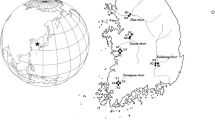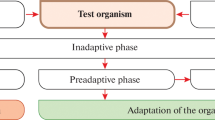Abstract
There is a need for establishing a marine bioassay test set to assess marine water and sediment samples in Germany. The selected marine bioassay test set, two tests for the water phase (with the luminescence bacteria Vibrio fischeri and the algae Phaeodactylum tricornutum Bohlin) and a whole sediment test with the marine amphipod Corophium volutator (Pallas) is described and first results are shown.
Similar content being viewed by others
References
Andres, H.G. Zur Biologie und Ökologie des Amphipoden Corophium volutator Pallas, (Corophiidae) . Thesis, (1970). Germany: University of Hamburg.
Becker, D.S., Bilyard, G.R. and Ginn, T.C. (1990). Comparisons between sediment bioassays and alterations of benthic macroinvertebrate assemblages at a marine superfund site: Commencement Bay, Washington. Environ. Toxicol. Chem. 9 , 669–85.
Bellan-Santini, D. (1980). Relationship between populations of amphipods and pollution. Mar. Pollut. Bull. 11 , 224–27.
Bjørnestad, E., Petersen, G.I., Robson, M., Reiersen, L.O., Henriquez, L., Massie, L. and Blackman, R. (1993). Paris Commission ring test: testing of offshore chemicals and drilling mud on selected marine organisms. The Science of the Total Environment, Supplement , 713–19.
Bowmer, C.T. (1994). Paris Commission Sediment Reworker Ring-Test, 1993—Technical Report Delft, Netherlands. TNO Environmental and Energy Research. IMW-R 93/317. 42 pp.
Brils, J., Stronkhorst, J. and van de Guchte, K. (2000). The status and use of bioassays for the assessment of contaminated sediments in the Netherlands. In J. Gandrass, W. Salomons and U. Förstner, (eds). Workshop on River Sediments and Related Dredged Material in Europe—Scientific Background from the Viewpoints of Chemistry, Ecotoxicology and Regulations . 3–5 April 2000, pp. 12–16. Geesthacht Germany: GKSS Research Centre.
Bundesanstalt, für, Gewässerkunde, (BfG). (1999). Handlungsanweisung für den Umgang mit Baggergut im Küstenbereich (HABAK-WSV). Bundesanstalt für Gewässerkunde . 25 pp. Koblenz, Germany.
Chapman, P.M., Swartz, R.C., Roddie, B., Phelps, H.L., van den Hurk, P. and Butler, R. (1992). An international comparison of sediment toxicity tests in the North Sea. Mar. Ecol. Prog. Ser 91 , 253–64.
DIN EN ISO 10253 (1998). Wachstumshemmtest mit marinen Algen Skeletonema costatum und Phaeodactylum tricornutum . 15 pp. Berlin, Germany: Beuth Verlag GmbH.
DIN EN ISO 11348–2 (1999). Bestimmung der Hemmwirkung von Wasserproben auf die Lichtemission von Vibrio fischeri (Leuchtbakterientest) Teil 2: Verfahren mit flüssig getrockneten Bakterien. Berlin, Germany: Beuth Verlag GmbH. 18 pp.
DIN EN ISO 11348–3 (1999). Bestimmung der Hemmwirkung von Wasserproben auf die Lichtemission von Vibrio fischeri (Leuchtbakterientest) Teil 3: Verfahren mit gefriergetrockneten Bakterien. Berlin, Germany: Beuth Verlag GmbH. 18 pp.
Fanuko, N. (1981). On the growth of marine diatom Phaeodactylum tricornutum in the batch culture. Acta. Bot. Croat. 40 , 111–16.
Gandrass, J., Salomons, W. and Förstner, U. (eds). (2000). Workshop on River Sediments and Related Dredged Material in Europe—Scientific Background from the Viewpoints of Chemistry, Ecotoxicology and Regulations. 3–5 April 2000, 83 pp. Geesthacht Germany: GKSS Research Centre.
Hall, L.W. Jr. and Anderson, R.D. (1995). The influence of salinity on the toxicity of various classes of chemicals to aquatic biota. Crit Rev Toxicol. 25 , 281–346.
Heijerick, D.G., Vangheluwe, M.L., Janssen, C.R. and Dumon, G. (2000). Selection and use of marine toxicity assays to assess the quality of dredged sediments. In J. Gandrass, W. Salomons and U. Förstner (eds). Workshop on River Sediments and Related Dredged Material in Europe—Scientific Background from the Viewpoints of Chemistry, Ecotoxicology and Regulations. 3–5 April 2000. pp. 30–40. Geesthacht Germany: GKSS Research Centre.
Helsinki Commission (HELCOM) (1992). Revised guidelines for the disposal of dredged spoils. 12 pp.
Hill, I.A., Matthiessen, P. and Heimbach, F. (eds). (1993). Guidance document on sediment toxicity tests and bioassays for freshwater and marine environments . 105 pp.
Intergovernmental Oceanograhic Commission (IOC), United Nations Environment Programme (UNEP) and International Maritime Organisation (IMO) (1999). Global Investigation of Pollution in the Marine Environment (GIPME)—Final Report on Guidance on Assessment of Sediment Quality. 20 pp.
Klein, B. (1991). Erfahrungen mit Leuchtbakterientests. Hildesheim, Germany. Niedersächsisches Landesamt für Ökologie, 41 pp.
Krebs, F. (1992a). Der Leuchtbakterientest für die Wassergesetzgebung. In K.G. Steinhaeuser, and P.D. Hansen (eds). Biologische Testverfahren , pp. 591–624. Stuttgart Germany: Gustav Fischer Verlag. Schr.-Reihe Verein WaBoLu.
Krebs, F. (1992b). Gewässeruntersuchung mit dem durch Alkali-und Erdalkalionen-Zugabe optimierten DIN-Leuchtbakterientest, dargestellt am Beispiel der Saar. In K.G. Steinhaeuser and P.D. Hansen (eds). Biologische Testverfahren , pp. 657–73. Stuttgart Germany: Gustav Fischer Verlag. Schr.-Reihe Verein WaBoLu.
London Convention (Scientific Group) (2000). Waste Assessment Guidance: Development of Waste-specific Guidance—Draft Specific Guidance of Assessment of Dredged Material—Dredged Material Assessment Framework. 28 pp.
Matthiessen, P. (2000). BEQUALM Newsletter—Biological Effects Quality Assurance in Monitoring Programmes (BEQUALM), 25 pp.
Munawar, M., Munawar, I.F., Ross, P. and Dermott, R. (1992). Exploring aquatic ecosystem health: a multi-trophic and an ecosystemic approach. J. Aquat. Ecosys. Health 1 , 237–52.
Nendza, M. (2000). Inventory of Marine Biotest Methods for the Evaluation of Dredged Material and Sediments, 63 pp. Berlin: Umweltbundesamt.
Oslo and Paris Commission (OSPARCOM) (1995). PARCOM Protocols on Methods for the Testing of Chemicals used in the Offshore Industry, 35 pp.
Oslo and Paris Commission (OSPARCOM) (1997). JAMP Guidelines for General Biological Effects Monitoring, 12 pp.
Oslo and Paris Commission (OSPARCOM) (1998). OSPAR Guidelines for the Management of Dredged Material, 32 pp.
Pastorok, R.A. and Becker, D.S. (1990). Comparative sensitivity of sediment toxicity bioassays at three superfund sites. In W.G. Landis, and W.H. van der Schalie (eds). Aquatic Toxicology and Risk Assessment 13 : 13 pp., ASTM 123–39, Philadelphia, USA.
Pedersen, F., Bjørnestad, E., Andersen, H.V., Kjolholt, J. and Poll, C. (1998). Characterization of sediments from Copenhagen Harbour by use of biotests. In W. Calmano, P. Roeters, and T. Vellinga (eds). Contaminated Sediments Vol. 37(6), 233–40.
Peters, C. (2001a). International regulations concerning dredged material management. In J. Gandrass, and W. Salomons (eds). Dredged Material in the Port of Rotterdam—Interface between Rhine Catchment Area and North Sea, pp. 214–29. Geesthacht Germany: GKSS.
Peters, C. (2001b). The national policy framework in Germany—dredged material management. In J. Gandrass, and W. Salomons (eds). Dredged Material in the Port of Rotterdam—Interface between Rhine Catchment Area and North Sea, pp. 171–81. Geesthacht Germany: GKSS.
Roddie, B.D. and Thain, J.E. (2001). Biological effects of sediment-bound contaminants: Corophium spp. sediment bioassays and toxicity test. International Council for the Exploration of the Sea (ICES). Techniques in marine environmental sciences (TIMES). 128, 26 pp.
Rudolph, P. (1992). Erkenntnisgrenzen biologischer Testverfahren zur Abbildung ökologischer Wirklichkeiten. In K.G. Steinhaeuser and P.D. Hansen (eds). Biologische Testverfahren Schr-Reihe Verein WaBoLu, pp. 25–34. Stuttgart Germany: Gustav Fischer Verlag.
Schellenberg, A. (1942). Krebstiere oder Crustacea, IV: Flohkrebse oder Amphipoda. In M. Dahl and H. Bischoff (eds). Die Tierwelt Deutschlands und der angrenzenden Meeresteile , pp. 218–21. Jena Germany: Gustav Fischer Verlag.
Swartz, R.C., DeBen, W.A., Sercu, K.A. and Lamberson, O. (1982). Sediment toxicity and the distribution of amphipods in Commencement Bay, Washington, USA. Mar. Pollut. Bull. 13 , 359–64.
Thain, J.E., Allen, Y., Reed, J. and Murray, L. (2000). Use of bioassays in assessing the toxicity of dredged material: experience in England UK. In J. Gandrass, W. Salomons and U. Förstner (eds). Workshop on River Sediments and Related Dredged Material in Europe—Scientific Background from the Viewpoints of Chemistry, Ecotoxicology and Regulations. 3–5 April 2000, pp. 17–19. Geesthacht Germany: GKSS Research Centre.
Traunspurger, W. and Drews, C. (1996). Toxicity analysis of freshwater and marine sediments with meio-and macrobenthic organisms: a review. Hydrobiologia 328 , 215–61.
van den Hurk, P., Chapman, P.M., Roddie, B. and Swartz, R.C. (1992). A comparison of North American and West European infaunal amphipod species in a toxicity test on North Sea sediments. Mar. Ecol. Prog. Ser. 91 , 237–43.
Weideborg, M., Vik, E.A., Ofjord, G.D. and Kjonno, O. (1997). Comparison of three marine screening tests and four Oslo and Paris Commission procedures to evaluate toxicity of offshore chemicals. Environ. Toxicol. Chem. 16 , 384–89.
Zimmer, M. and Ahlf, W. (1994). Erarbeitung von Kriterien zur Ableitung von Qualitätszielen für Sediment und Schwebstoffe—Literaturstudie UBA Texte 69/94, 309 pp. Berlin Germany: Umweltbundesamt.
Author information
Authors and Affiliations
Corresponding author
Rights and permissions
About this article
Cite this article
Peters, C., Becker, S., Noack, U. et al. A Marine Bioassay Test Set to Assess Marine Water and Sediment Quality–its Need, the Approach and First Results. Ecotoxicology 11, 379–383 (2002). https://doi.org/10.1023/A:1020565507532
Issue Date:
DOI: https://doi.org/10.1023/A:1020565507532




